Photographs: Ramila Rego
With the snow capped Himalayas in the backdrop, the camel ride in Ladakh was one of the most memorable moments for Ramila Rego.
There is something magical about the Himalayas and so very irresistible to the adventurous traveller like me. This time around I was in ecstatic Leh, the capital of Ladakh, situated at about 11,000 feet above sea level, on the banks of the Indus in Jammu & Kashmir.
Leh is accessible by road only between May and October from Manali (473 km) and Srinagar (434 km), as it is blocked by snow the rest of the year. From Delhi (1047 km), the easiest way to get to Leh is by air.
Want to share your travel story with us and others around the world? Simply write an email (with the subject line: 'My Travel Story') and send it to getahead@rediff.co.in! Also send us pictures of the place you're writing about. We will publish the best ones right here on rediff.com!
Acclimatization is essential
The best time to visit is between June and August as the roads are open to the public, the weather condition is favourable for adventure sports and trekking activities, the skies are clear and the mountain peaks visible.
85 percent of those visiting Leh for the first time face high altitude illness due to the low level of atmospheric oxygen.
It takes at least two days to acclimatize to these high altitudes. You have to be completely fit and well clad to enjoy the place.
It was freezing cold in May
Image: The 32 metre statue of Maitreya Buddha near Diskit Monastery.When I visited the place in mid-May, it was freezing cold with the temperature between zero and minus 6 degrees. It snowed occasionally.
Travelling from a desert (Dubai), it is essential to be a little more cautious and book rooms with central heating, available only in a very few select hotels in Leh. The place has rudimentary hotels. Being a teetotaller I survived with hot water and chai.
The package included a tour guide who took care of the requisite permits and an Innova with a driver.
Give a driver in Leh a power steering and he takes off like Schumacher on the meandering, rugged roads of Ladakh. I had to hold on to the seat in front while requesting him to slow down.
Spectacular views
People advise that you climb to an altitude, spend some time at that altitude and then move to higher altitudes, in order to acclimatize. I did just that.
I spent two days in Leh, visited the Shanti Stupa, Stok Palace, Thiksey monastery, the Indus valley, the village, the market area and then visited places at higher altitudes.
Shanti Stupa: My stay was in Changspa and I walked to the hilltop where Shanti Stupa is located, 20 minutes away. The walk actually helped me acclimatize better. A magnificent white-domed structure, the Shanti Stupa offers spectacular views of Leh.
One of the most beautiful monasteries in Ladakh
Image: Thiksey MonasteryStok Palace: Leh palace is modelled on the Potala Palace in Lhasa, Tibet. It is nine storeys high; the upper floors accommodated the royal family while the stables and store rooms are in the lower floors.
The rooftop offered panoramic views of Leh and it was a good photography opportunity.
Thiksey Monastery: Thiksey is one of the most frequently visited and most beautiful monasteries in Ladakh, about 20 km away from the town of Leh.
It houses a 40 feet tall statue of Maitreya Buddha and is one of the finest examples of Ladakhi architecture. The 12-storey monastery complex has a rich collection of Buddhist artefacts like thankas (prayer flags), wall paintings etc, a large pillar engraved with the Buddha's teachings and a number of sacred shrines.
Buddhist tales
Image: A Buddhist monk narrated stories of the Dalai Lama's visit to Diskit Monastery.The Nubra Valley, also called the Valley of Flowers, is about 5-6 hours away by road to the north of Leh and takes you through the Khardungla pass, the world's highest motorable pass standing at a mighty height of 18,380 feet.
The entire village was dotted with pink blossomed apricot plantations.
We visited the 350 year-old Diskit Gompa the oldest, and the largest monastery in the Nubra Valley where a Buddhist monk offered us a warm cup of chai and narrated stories of the Dalai Lama's visit.
Atop a double humped camel
Image: A camel ride un Hunder village.Very close to Diskit is a quaint little village called Hunder with sand dunes and double humped camels.
I took a camel ride which was one of the most memorable moments of this trip -- perfect weather, good company, add to it the backdrop of the snow capped Himalayas, simply splendid!
My camel was named Dinosaur as he had the biggest hump.
Frozen lake
Soon after we headed to the hot water sulphur springs at the village of Panamik, believed to have certain medicinal qualities that cure a number of ailments.
On our way back to Leh we were stuck for 5 hours at the Khardungla pass, in freezing temperature, without food or drinking water, no toilet facilities, and with a car that had no heating facility. So travellers, be prepared for such eventualities.
Our final trip was to Pangong Lake, about 150 km to the east of Leh. The 150 km long and 4 km wide lake is located at an altitude of 14,000 feet. The river was frozen when we went, yet it is a gorgeous sight.
The drive to Pangong Tso took us through the Changla pass at 17586 feet. It was quite an entertaining drive with hilarious road safety messages that read: Go low on my curves, If you are married - divorce speed.
It is a 3 to 4 hour drive up the meandering road with very few eating options on the way. Maggie noodles seemed to be very popular and was available everywhere.
Those seven magnificent days in Leh, felt like I really was on top of the world.
Of course the bumpy takeoff from Leh airport for the flight back to Delhi brought me right back to Mother Earth!
Want to share your travel story with us and others around the world? Simply write an email (with the subject line: 'My Travel Story') and send it to getahead@rediff.co.in! Also send us pictures of the place you're writing about. We will publish the best ones right here on rediff.com!

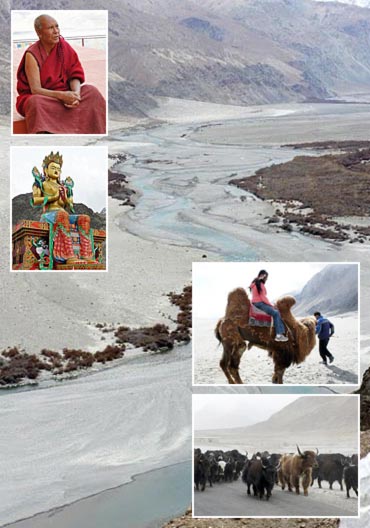

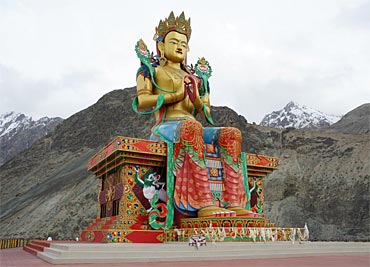

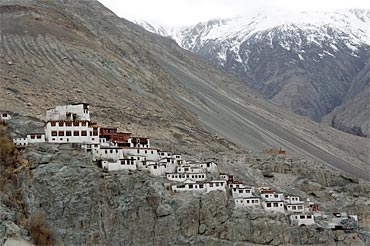
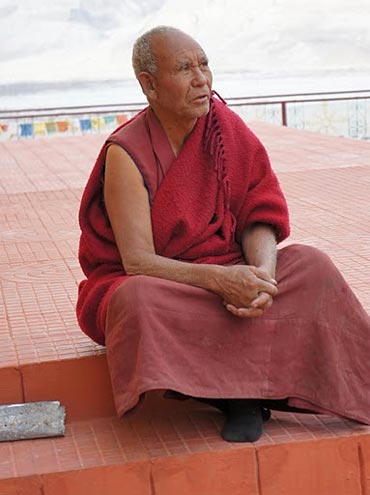
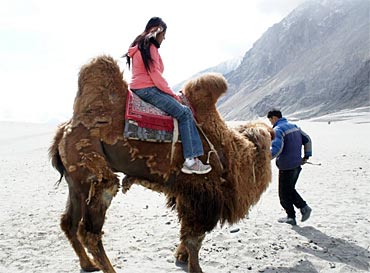
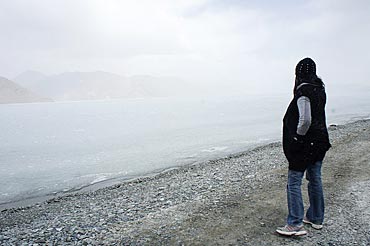
Comment
article